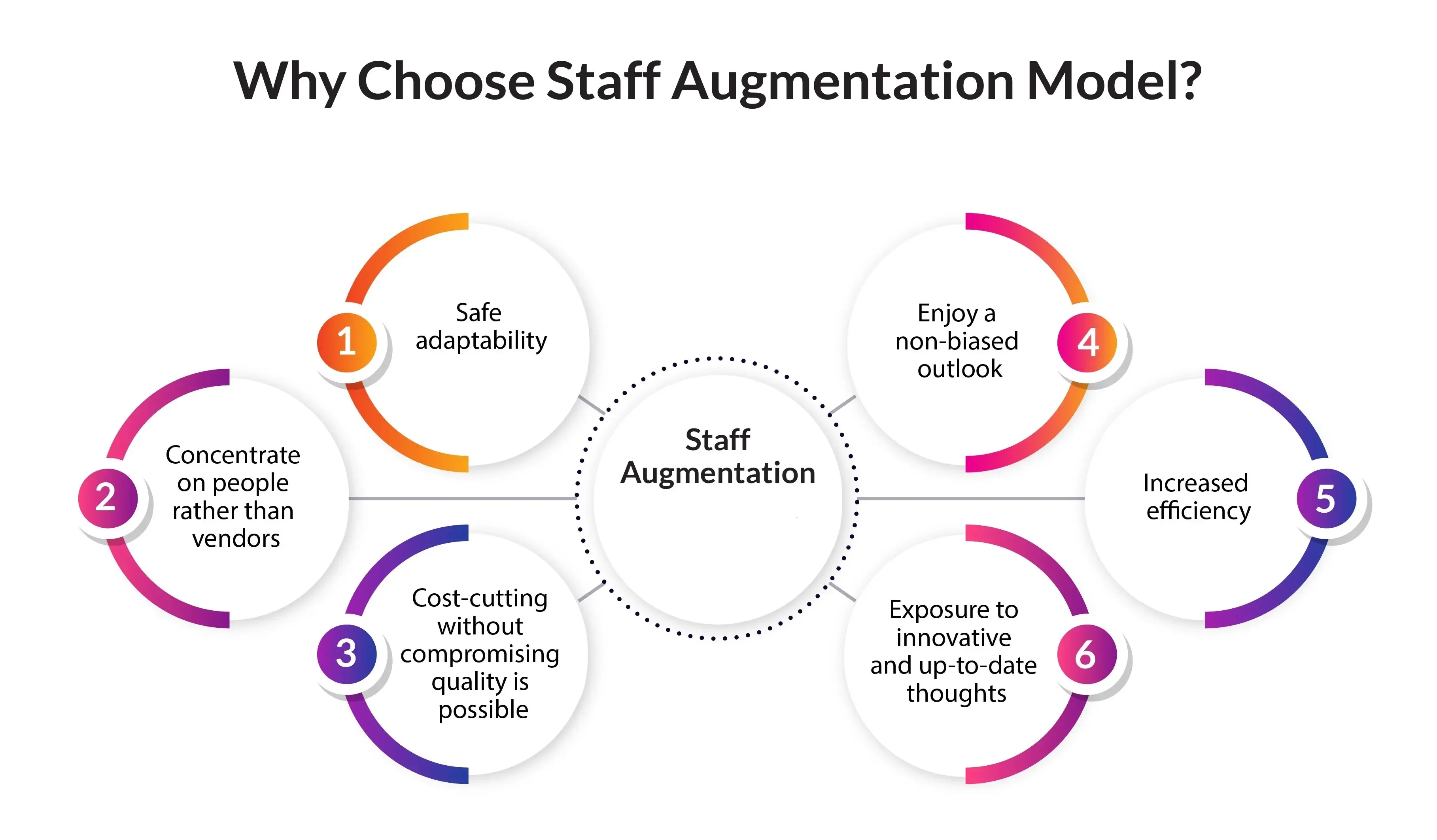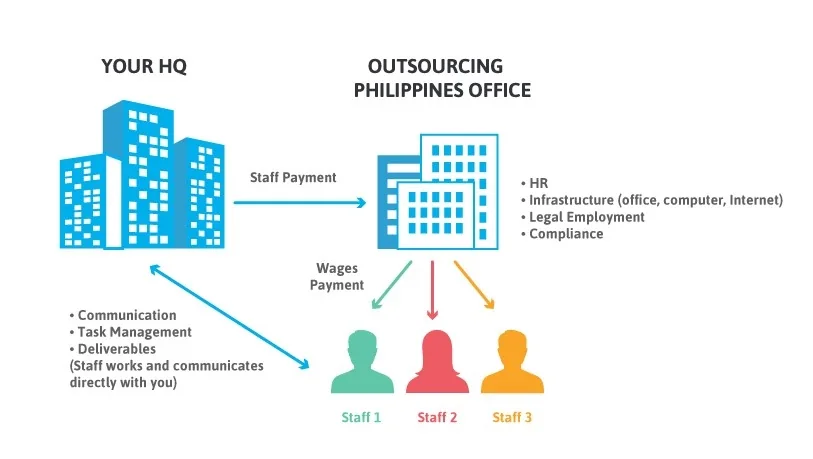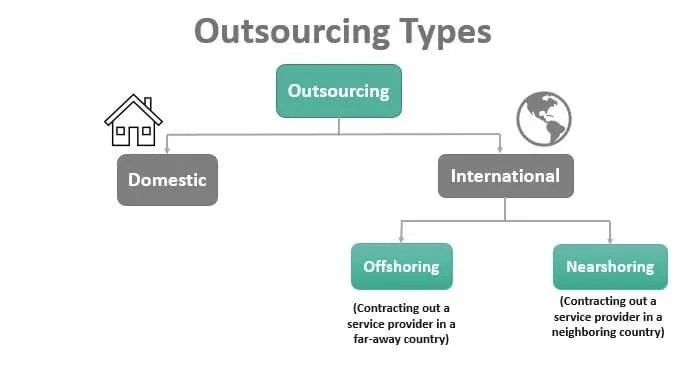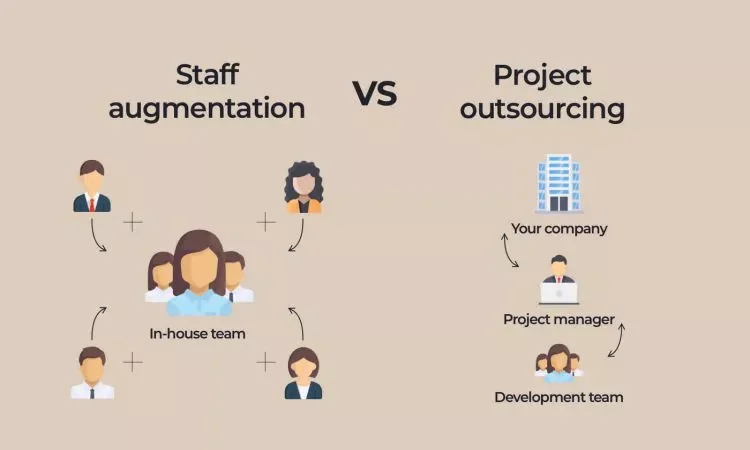As a software firm, your company's ability to compete resonates with its success. This includes cutting costs, surging up the developmental phase, and much more. One way or the other, it all narrows down to the efficiency of the development team. To achieve all this and support your in-house team, you must decide between staff augmentation vs outsourcing to meet your IT project demands.
Your company's productivity may also suffer greatly if you can’t keep up with the new and cutting-edge technologies that are developed. Your business will require a skilled external or internal team under such circumstances.
For that matter, the IT sector is indebted to the resource engagement models like staff augmentation or outsourcing talent. While these engagement models can be of great help, it is important to know what will work out best for your needs. If you're overwhelmed with tasks and need specialized support, it might be beneficial to a hire virtual assistant who can handle specific aspects of your workload, providing flexibility and expertise as needed, to support your augmentation/outsourcing efforts.
So here is all that you need to know about staff augmentation vs outsourcing. We’ll be discussing both models in greater detail with their advantages and disadvantages. By the end of this guide, you’ll know the key differences between the two models and how these two might work out best for your situation.
What Is Staff Augmentation?

Employing temporary workers to fill in your company's specific skill gaps is known as staff augmentation. Although temporary, workers you hire in this way are still considered employees of your business.
Depending on the demands of the short-term project or contract, you appoint employees with specialized knowledge to your team. Your project team may require augmented employees at various developmental stages. Their goal is to advance your project using their skill set.
3 Types Of Staff Augmentation
There are three main types of staff augmentation your company can benefit from, let’s take a look at them.
- Commodity
- Skill-based
- Highly skilled
1. Commodity
With this kind of staff augmentation, you can have competent staff that can handle a range of jobs like:
- Retail
- Events
- Manual tasks
- Warehouse jobs
This augmentation type is frequently chosen when there is a need for immediate staff recruitment because it does not require you to employ skilled workers to complete a certain task.
2. Skill-Based
By using skill-based staff augmentation, you can meet your company's demands for several job categories like clerical tasks, data processing, transcribing, and simple copywriting. For this kind of staff augmentation, a minimal skill level is required.
3. Highly Skilled
These teams operate at the highest level and are made up of highly skilled experts with a variety of abilities that are crucial for completing complex and large-scale projects. They stand out for working in an agile environment, being adaptable to the client, and producing high-standard outcomes.
Advantages Of Staff Augmentation

Below are the advantages of staff augmentation:
- Zero commitments
- Increase in capacity
- Management control
- Zero geographical limitations
A. Zero Commitments
You don't have to be concerned about long-term commitments while using staff augmentation services. When your requirements are high, you can employ developers from a variety of service providers and release them once you are finished.
This is done to make better use of the resources over a longer period. Any business that offers staff augmentation services will provide you with a developer who can collaborate with your in-house team within a few hours.
B. Increase In Capacity
You'll require more qualified developers for your software development projects as your organization expands. In such circumstances, staff augmentation can help you by allowing you to hire extra developers and complete the job. They collaborate with your full-time employees and boost your company's overall productivity without adding much expense.
C. Management Control
Staff augmentation models will provide you with more control over your project's development. Even though the team is implementing your plan, you won't feel excluded. You can ensure that they adhere to your company's coding standards and working hours which will enable you to collaborate with them while retaining direct control over the resources.
D. Zero Geographical Limitations
You can employ skillful resources from any place to work on your project remotely if there is a shortage of experts in your area. Under this system, workers are typically expected to work remotely, communicate with an on-site team, and adjust to time zone variances.
Disadvantages Of Staff Augmentation
Below are some of the disadvantages of staff augmentation:
- High cost of training
- Possible delays
- Risk of low-quality production
- Long-term costs
I. High Cost Of Training
There are differences between your internal team and an augmented team, even though it may seem like the augmented workforce is a part of your team. You must first introduce them to your company's mission. Once they are familiar with this, you must teach the team to help you achieve your objectives, which typically necessitates spending a lot of resources.
II. Possible Delays
Onboarding and training take a lot of time and this can delay your project’s progress. The additional work may also feel difficult if your augmented employees won't be working there for long.
III. Risk Of Low-Quality Production
Even though outsourced teams often consist of highly experienced individuals, adding more IT employees carries some risks. Getting your augmented employees familiar with the project can be challenging if your IT project demands a lot of contexts. When familiarity is a must, it may be more beneficial to hire a dedicated employee.
IV. Long-Term Costs
If your project takes longer than expected, staff augmentation might not be beneficial for you. Augmented staffs cost more per hour than regular in-house staff. Hiring long-term augmented professionals might be bad for your budget.
Now let’s take a look at what outsourcing is and what are its advantages and disadvantages.
What Is Outsourcing?

Outsourcing is known as the process of assigning or subcontracting a part of a project or function to a third party.Outsourcing companies are more accountable for the entire project's quality and outcome. To achieve a successful relationship while outsourcing, it is necessary for both businesses to function on a foundation of mutual trust.
Your company can outsource its needs for web design, app development, or digital marketing to agencies or freelance marketers. Even if you have the option of using in-house staff for these goals, there are times when it makes sense to outsource specific tasks to save costs and save time.
6 Types Of Outsourcing
There are six main types of outsourcing models your company can benefit from, let’s take a closer look at them.
- Process outsourcing
- Project outsourcing
- Professional outsourcing
- Onshore outsourcing
- Offshore outsourcing
- Nearshore outsourcing
1. Process Outsourcing
Your business can use process-specific outsourcing to save expenses while also freeing up time and resources to concentrate more on your core operations and reduce the time it normally takes to complete customer orders.
2. Project Outsourcing
When you have a lot of unfinished software projects and tight deadlines and have trouble managing them, they can be outsourced to project management companies. This also includes outsourcing projects your in-house staff are not qualified enough to handle because it will save you time and money to complete.
3. Professional Outsourcing
One of the most common forms of outsourcing is professional outsourcing because it has the potential to save a lot of money and fill skill gaps. Your business has access to top-notch resources and highly skilled professionals, and you only pay for the services that are rendered, which considerably lowers overhead costs.
4. Onshore Outsourcing

In onshore outsourcing, a company employs a vendor who is based in the same country to help with project development and management, business processes, or both. Being located in the same country ensures improved communication, better monitoring, and greater control over the processes and systems.
5. Offshore Outsourcing
Offshore outsourcing is very similar to onshore outsourcing. The only difference is that in offshore outsourcing, the service provider hired by the organization to perform specific business functions is located in a different country. Offshore outsourcing offers lower costs, greater flexibility, and access to a large pool of highly-skilled global talent.
6. Nearshore Outsourcing
In nearshore outsourcing, the project or system is outsourced to a service provider that is based in another country that is either neighboring or is located in the same continent. By opting for nearshore outsourcing, companies can benefit from cultural compatibility and a similar time zone which results in increased productivity and better coordination.
Advantages Of Outsourcing
Below are some advantages of outsourcing:
- Access to highly skilled professionals
- Cost-effective
- Management Offload
A. Access To Highly Skilled Professionals
When you choose project outsourcing processes, you have access to the best talent that the world has to offer. This approach enables you to connect with and access people with core competencies from around the world, which would not have been possible in an office environment.
B. Cost-Effective
Choosing an IT project outsourcing service can help you save a significant amount of money. When done correctly, you can avoid paying for hiring, onboarding, training costs, retaining, etc. as a whole.
C. In-House Team Work Offload
When you outsource projects, you allow your house employees to complete other pending projects. This flexibility allows you to assign dedicated teams to other important tasks.
Disadvantages Of Outsourcing
Below are some of the disadvantages of outsourcing:
- Zero confidentiality
- Risk of Low-quality production
- Time-consuming
I. Zero Confidentiality
You never know when your data might be compromised or when your codes might be published online. This could be disastrous for your business. When choosing an offshore vendor or development team, you should exercise extreme caution and sign an NDA with them.
All of your source codes, business models, and business information stay with the external vendor you use to outsource your project.
II. Risk Of Low-Quality Production
Another disadvantage of this model is the possible low quality of the final product. This is primarily due to a lack of supervision and monitoring.
When you hire an offshore vendor to complete your project, quality can be compromised if you are not cautious when selecting an outsourcing partner. Technical issues originating from an outsourced development team, faults that don't meet your company's strict development standards, and unreported technical debt can be challenging to fix.

Aloa, which has a rigorous verification process in place, is the finest company to work with because it relieves its clients' stress. We thoroughly examine your project to choose the ideal framework and the most qualified experts for the job. This method guarantees that there won't be any problems in the later stages of development and that everything will go smoothly the entire time.
III. Time-Consuming
The advancement of project-based outsourcing might be sluggish. Before the project begins, all details must be laid out during the planning and all legal paperwork must be completed. Improper project planning leads to a prolonged product launch time.
Now that you understand staff augmentation vs outsourcing, let us take a look at the differences between them.
Staff Augmentation Vs. Outsourcing – 5 Key Differences

Here’s a quick rundown of the key differences between staff augmentation and outsourcing.
i. Expenses And Responsibilities
When an entire team is outsourced, the vendor also pays for:
- Utilities
- Benefits
- Hardware
- Office space
- Software licenses
- Employee training
Additionally, they are also supposed to look out for the general well-being of software professionals. Therefore, outsourcing could be an expensive choice for pressing needs but is the best answer for long-term project requirements.
On the other hand, your company might incur a lot of costs in extending augmented staff contracts if your project takes longer than expected. However, when staff augmentation is executed well in the short term, it can lead to lower costs, higher employee loyalty, and a better retention rate.
ii. Project Management
In the staff augmentation approach, you manage your project internally even though you have the help of outside contractors.
On the other hand, employing a dedicated outsourcing team also includes engaging a project manager, which reduces your project management responsibilities by having the vendor assume a complete management role for the project requirements.
iii. Training
When a project is outsourced, the requirement for training is minimal since the hired experts work on it while following the terms and conditions. Staff augmentation requires businesses to guide, onboard, and train new recruits. They must learn about the company's culture, objectives, and goals before they can start working on a new project.
iv. Client And Company Relationship
The success of a project is greatly influenced by the company and the vendor having a positive connection. The vendor participates directly in the project lifecycle when projects are outsourced. For a better partnership, the terms and conditions between the two sides must be spelled out.
However, in staff augmentation, the vendor plays a considerably smaller role because firms engage with experts after the vendor has closed the sale.
v. Business Model Insights
The fact that augmented developers typically don't have familiarity with your company, internal processes, or your industry insights is another drawback of temporary employment. As a result, you can't anticipate them to be as aggressive or creative as a typical employee.
The ability to handle your demands in a personalized manner is provided by a dedicated team supplier, which is another advantage of outsourcing a dedicated team over staff augmentation. The team also has an excellent opportunity to learn about your company and understand your genuine needs.
Staff Augmentation Vs. Outsourcing – Which Model Is Best For Your Business?
Staff augmentation has certain undeniable advantages. When your company needs quick results with a small budget involved, it can be one of the most effective ways to handle short projects. However, as a project gets longer, the advantages of staff augmentation tend to diminish.
The efficiency and benefits of working with a remote software house will increase as the length and complexity of the IT project increase. Some firms specialize in both staff augmentation and outsourcing and they are trustworthy and knowledgeable about managing IT projects.
It's not simple to pick the best digital delivery approach. The idea of "one size fits all" does not apply in this situation, thus you will need to take into account several factors. They consist of:
- The project's timing and the deadline to launch the product
- The technical expertise and availability of your internal team
- The project specifications and technical expertise required for it
- The amount of money your company is willing to spend on software development
When you are short on certain skills, you can use this straightforward approach to decide whether staff augmentation or IT outsourcing is best for you:
- Will your project become long-term at some point?
- Does the project relate to the business's primary activities?
- What level of control do you want for the project and team management?
- Does the project already have a team in place (i.e., only a few specialists are still needed)?
Your answers to the questions above determine which model is best for your business, or if you will be going for both methods. You can choose between staff augmentation and software outsourcing depending on business needs, financial constraints, and the factors mentioned above.
Conclusion
The process of selecting between staff augmentation vs outsourcing might be difficult. This complexity is increased by several factors like a company's IT and personnel budgets, staffing, technical skill sets of current employees, project security, and deadlines.
This is why it is advisable to consult firms like us at Aloa that offer services in both staff augmentation and IT project outsourcing. We can help you with making an informed choice on what’s best for your company or product, by carrying out extensive research and gathering useful information.
We know how difficult it can be to get help, and this is why we have made it easy to reach out to us via email at [email protected] or by visiting our website. We are always available to answer your questions and guide you toward making the best decisions for your product or business.

